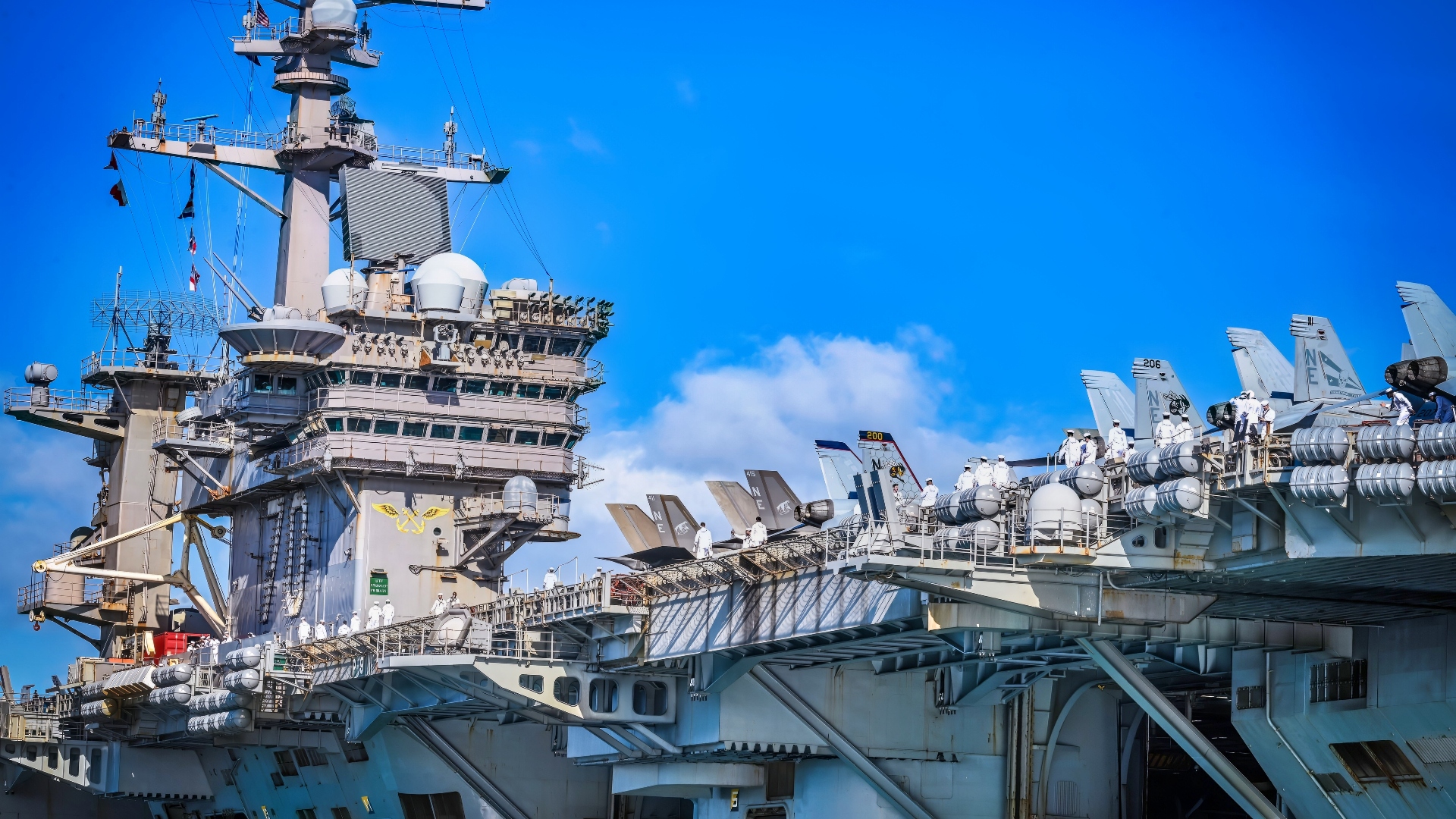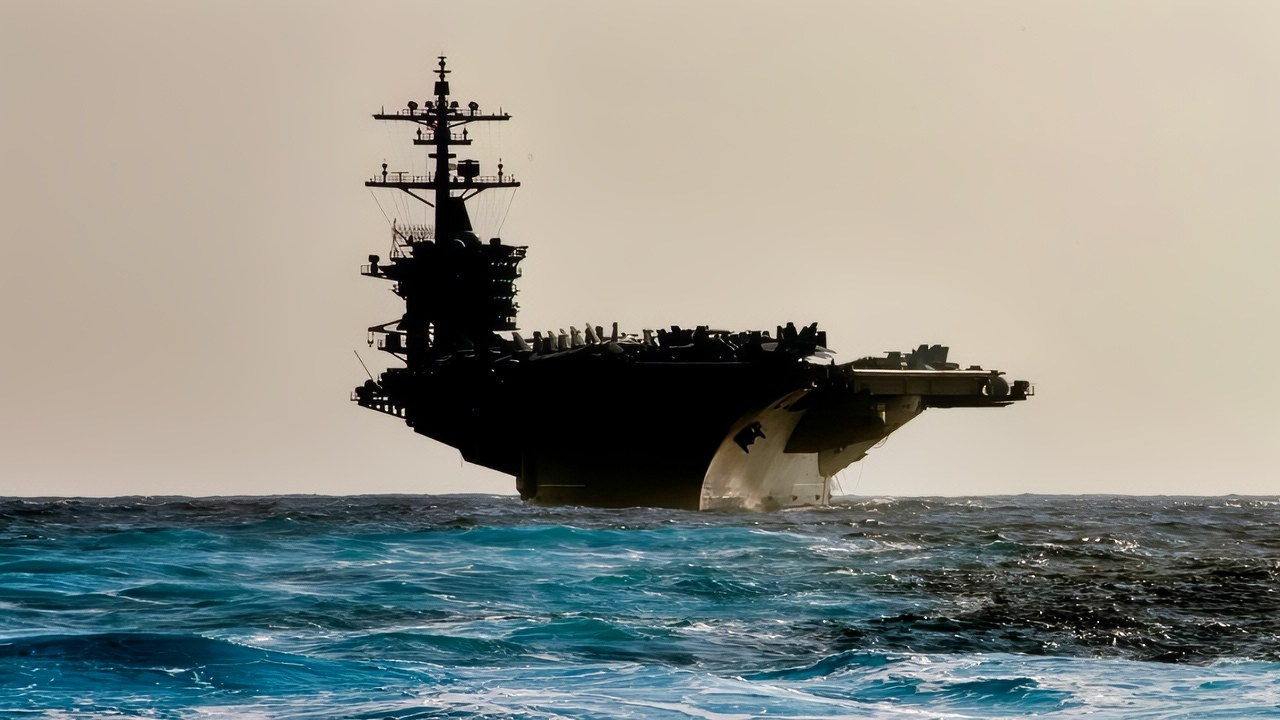Key Points and Summary – The USS Carl Vinson (CVN-70) is the third Nimitz-class nuclear-powered supercarrier, commissioned in 1982.
-With a distinguished service history spanning over four decades, it has participated in numerous combat operations, including Desert Strike, Iraqi Freedom, and Enduring Freedom, as well as recent strikes against Houthi targets.

The Nimitz-class aircraft carrier USS Carl Vinson (CVN 70) arrives in Joint Base Pearl Harbor-Hickam, Hawaii, for a scheduled port visit, July 30, 2025. Vinson, the flagship of Carrier Strike Group ONE, is underway conducting routine operations in the U.S. 3rd Fleet area of operations. (U.S. Navy photo by Roann Gatdula)
-The massive warship, capable of carrying 90 aircraft and over 6,000 personnel, famously served as the site for Osama bin Laden’s burial at sea in 2011.
While still an active and formidable part of the U.S. Navy fleet, the Vinson is slated for retirement around 2032.
USS Carl Vinson (CVN-70): A History of an Amazing Aircraft Carrier
The Carl Vinson (CVN 70) is the third United States Navy Nimitz-class aircraft carrier and is named after Carl Vinson, a Congressman from Georgia.
The Vinson was commissioned during a ceremony at Newport News Shipbuilding and Drydock Corp. in Newport News, Va., on March 13, 1982.
The USS Carl Vinson is one of ten Nimitz-class aircraft carriers that are currently active with the U.S. Navy.
As the third nuclear-powered supercarrier of its class, she has left a legacy spanning more than four decades, marked by global deployments, combat operations, humanitarian missions, and cultural milestones.
The supercarrier is still active and slated for retirement around 2032.
The Carl Vinson’s First Deployment Is Around the World
Her maiden deployment began in March 1983 and was a monumental eight-month around-the-world cruise. During this deployment, she operated in the Mediterranean, Atlantic, Indian Ocean, Arabian Sea, South China Sea, and Pacific Ocean.
She made port stops in Monaco, Morocco, the Ivory Coast, Australia, the Philippines, Japan, Korea, and Hawaii before arriving at her new homeport in Alameda, California, in October 1983.
Combat Deployments Of the USS Carl Vinson
The Vinson missed the first Gulf War as she was undergoing a 28-month overhaul in 1990.
The USS Carl Vinson has an extensive combat and operational record, including participation in Operation Desert Strike, Operation Iraqi Freedom, Operation Southern Watch, and Operation Enduring Freedom.
In 1994, the Vinson supported Operation Southern Watch, which enforced the no-fly zone over southern Iraq. During her seventh deployment in 1996 she conducted air operations in Operation Desert Strike and Exercise Rugged Nautilus. She earned her second Battle “E” award and additional commendations for her performance.
Most notably, in 2011, its deck was used for the burial at sea of Osama bin Laden following the Navy SEAL raid. The ship has also engaged in recent operations, including strikes against Houthi targets and participation in the Operation Inherent Resolve campaign against ISIS.

SOUTH CHINA SEA (Jan. 17, 2025) – The Nimitz-class aircraft carrier USS Carl Vinson (CVN 70) transits the South China Sea during a Maritime Cooperative Activity with the Philippine Navy, Jan. 17, 2025. The U.S. and Philippines work together as allies, enhancing the interoperability of maritime forces and supporting their shared goal of a free and open Indo-Pacific. Carrier Strike Group ONE, is underway conducting routine operations in the U.S. 7th Fleet area of operations. (U.S. Navy photo by Mass Communication Specialist 3rd Class Brianna Walker)

Sailors prepare to man the rails as Nimitz-class aircraft carrier USS Carl Vinson (CVN 70) arrives at Joint Base Pearl Harbor-Hickam for Exercise Rim of the Pacific (RIMPAC) 2024, June 25. Twenty-nine nations, 40 surface ships, three submarines, 14 national land forces, more than 150 aircraft and 25,000 personnel are participating in RIMPAC in and around the Hawaiian Islands, June 27 to Aug. 1. The world’s largest international maritime exercise, RIMPAC provides a unique training opportunity while fostering and sustaining cooperative relationships among participants critical to ensuring the safety of sea lanes and security on the world’s oceans. RIMPAC 2024 is the 29th exercise in the series that began in 1971. (U.S. Navy photo by Mass Communication Specialist 2nd Class Leon Vonguyen)
Support Ships in the Vinson Carrier Strike Group
A typical Nimitz Carrier Strike Group (CSG) typically includes the aircraft carrier itself, guided-missile cruisers, guided-missile destroyers, a Destroyer Squadron (DESRON) to command the surface ships, and an embarked Carrier Air Wing (CVW) of various aircraft. These components work together to provide defense, command and control, and offensive airpower for the strike group.
The components of Vinson’s Carrier Strike Group One include the aircraft carrier flagship, such as the Nimitz-class USS Carl Vinson (CVN-70), which provides the platform for launching and recovering aircraft.
Guided-Missile Cruisers, such as the Ticonderoga-class cruisers, provide air defense, command, and control for the strike group.
Guided-Missile Destroyers, like the Arleigh Burke-class destroyer,s offer a range of capabilities including anti-submarine, anti-surface, and anti-air warfare.
Destroyer Squadron (DESRON): A staff that provides command and control for the surface combatants (cruisers and destroyers) in the group.
The Carrier Air Wing (CVW) is a collection of various squadrons and aircraft that fly from the carrier, such as fighters, electronic warfare, and early warning aircraft, depending on the mission and the deployment.
A Nimitz-class aircraft carrier, with a top speed exceeding 30 knots (approximately 35 mph), can reach the Mediterranean Sea from the Atlantic Ocean in roughly 5-10 days, depending on its route and any stops along the way.
However, generally, the carrier strike group travels at a cruising speed of 20 knots.
The Vinson’s Size Makes It A Floating City
As a Nimitz-class carrier, the USS Carl Vinson displaces over 100,000 tons and measures 1,092 feet in length. She is powered by two Westinghouse A4W nuclear reactors and four steam turbines, allowing her to travel at speeds exceeding 30 knots and to have virtually unlimited range.
These reactors provide the aircraft carrier with electricity and propulsion, allowing it to operate at high speeds with virtually unlimited range and endurance, meaning it can sail for 20-25 years without refueling.
The two reactors are a key component of its Nimitz-class design, which enables the carrier to function as a self-contained mobile airport.
Her crew includes approximately 6,000 personnel, including both the ship’s company and air wing members. She can carry up to 90 fixed-wing and rotary aircraft, making her one of the most formidable warships in the world.
“We rehearse on a regular basis to ensure that we are ready, relevant, and able to conduct our full range of missions,” said Captain Matthew Thomas, the commanding officer of the Vinson. “Having both fifth-generation F-35s and Block III Super Hornets is a great additive capability to our air wing. They bring a lot of avionics capabilities that make us more capable and lethal.”
Nimitz-Class Carriers Are Still the Navy’s Centerpiece
The Nimitz-class carriers and their strike groups are the centerpiece of the US Navy. These modern carriers project immense power worldwide.
The Navy, however, announced in 2007 that the Ford-class carriers, the replacement for the Nimitz class, would begin replacing the Nimitz carriers.
The first four ships in the Gerald R. Ford class are the USS Gerald R. Ford (CVN-78), USS John F. Kennedy (CVN-79), USS Enterprise (CVN-80), and USS Doris Miller (CVN-81).
About the Author: Steve Balestrieri
Steve Balestrieri is a National Security Columnist. He served as a US Army Special Forces NCO and Warrant Officer. In addition to writing on defense, he covers the NFL for PatsFans.com and is a member of the Pro Football Writers of America (PFWA). His work was regularly featured in other military publications.
More Military
3 U.S. Navy Ohio-Class SSGN Missile Submarines Surfaced As A Warning To China
Why the U.S. Navy Legally Needs 11 Aircraft Carriers
China’s Mystery H-20 Stealth Bomber Can Be Summed Up Simply in Just 1 Word
RANKED: The U.S. Army’s 5 Best Handguns Of All Time
Why It’s Almost Impossible for the Houthis to Sink a U.S. Navy Aircraft Carrier










